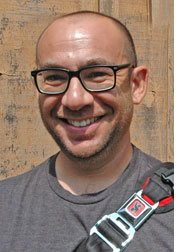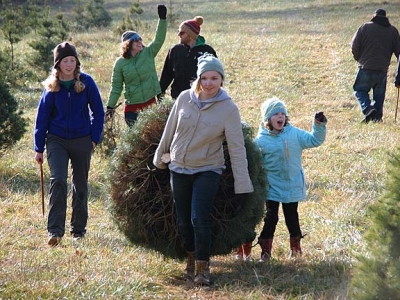YSHS/McKinney to open— New staff, new way of learning
- Published: August 22, 2013

Eli Hurwitz is the new librarian and media specialist for the Yellow Springs School District. Hurwitz will split his time between YSHS/McKinney and Mills Lawn Elementary School. A Yellow Springs resident, Hurwitz has taught English for 13 years and been a librarian for the past three years. (Photo by Megan Bachman)
Implementing the district-wide mandate will be difficult, but the educational benefits are worth it, YSHS/McKinney principal Tim Krier said this week.
“This is why I came out here. This is the kind of education I want for my family,” said Krier, whose son, Noah, enters the seventh grade at McKinney this year. “This will give kids the opportunity to be inventive and creative in a systematic way.”
School starts Wednesday, Aug. 21.
At a three-day paid teacher training in PBL this week, YSHS/McKinney teachers were to learn from High Tech High in San Diego, a pioneer in PBL education, and begin to craft their own projects for the year ahead. Each teacher is expected to create at least one nine-week PBL project, Krier said.
The new PBL curriculum will challenge teachers used to traditional instruction, so ongoing training and support from the administration is key, Krier added. The district has hired a half-time PBL coach to support teachers. Students will also have to adjust to the new curriculum, he said.
“Some students may think it’s easiest to learn when a teacher does a straight lecture. You take notes, pass a quiz, and it builds up to a test,” Krier said. “This isn’t like that. This is a transition to a class where you pursue things associated with the real world.”
The PBL model, which some teachers started to incorporate into their courses last year, has already begun to prove itself, Krier said. Physics and chemistry teacher Brandon Lowry taught his AP physics class using project-based learning, and though students were initially worried that they weren’t learning enough, their AP scores proved otherwise. Test scores were an average 50 points higher than the previous year and an impressive 86 percent of students passed the test, according to Krier.
To Krier, one of the most exciting PBL activities in the pipeline is a public art project in collaboration with the Yellow Springs Arts Council’s National Bronze Sculpture Symposium in October, with partial funding from the Ohio Arts Council. Every student taking an art class will create their own sculpture mold that will be cast in aluminum and erected on a public sculpture trail on the school’s campus. During the two-week symposium the four selected sculptors will also visit the school to give students feedback on their work, which Krier said is, “to a T what PBL is supposed to do.”
“We’re lucky to come out of the gates with something so neat,” Krier said. “This is a really authentic application with experts providing feedback to kids.”
In another PBL initiative this year, each high school student will also have a sustainable agricultural experience that counts as a science credit. Two garden hoop houses will be erected on the south side of the building for student-designed projects and Bradley Lokai will teach sustainable agriculture part time. The project is funded by the Greene County Career Center.
Other PBL projects are still being designed. Seventh-grade math and science teacher Jack Hatert is developing a project based upon a TED talk about the zombie apocalypse during which students will design a community to keep out zombies and source food and supplies. In another project math students will build paper roller coasters two to three stories high while learning about engineering concepts. With 10 new digital cameras, students will be able to create their own documentaries.
To support the PBL curriculum, YSHS and McKinney will transition to a modified block schedule with double periods on Wednesdays and Thursdays and regular seven-period days the rest of the week. In June the McKinney and YSHS staff voted 18–5 in support of the new schedule.
The high school will also offer a MOOC (massive open online course) “Think Again: How to Reason and Argue” taught by two Duke University professors. Completion of the course earns student up to one college credit through Antioch University. With this course and other PBL projects, Krier hopes that YSHS students can help solve problems in the local community.
“My hope is that our young people will lead the community on how to discuss things in ways that are not hostile but are productive and solutions-oriented,” Krier said. “I think we can develop practices here that can influence the effectiveness and efficiency and direction of the community.”
Enrollment this year is on par with last year, though registrations are still coming in. There are 338 students enrolled at both schools, about 15 more than last year, with 211 students at YSHS and 127 at McKinney.
Joining the school staff is health and physical education teacher Angela Bussey, librarian and media specialist Eli Hurwitz and band and orchestra teacher Brian Mayer. Mayer, a YSHS alum, was selected from 40 candidates who were interviewed in depth and given the opportunity to lead the Yellow Springs Community Band. A Yellow Springs resident, Hurwitz, has taught English for 13 years and been a librarian for the last three years.
In addition to the move to PBL, Krier’s administration must also implement new mandates from the State of Ohio, including the Common Core standards and more frequent teacher evaluations.
Though the workload will be intense, Krier looks forward to continuing to raise the bar at YSHS and McKinney, which had some significant academic achievements last year. Among the accomplishments were the highest AP scores in U.S. history and physics in school history, AP scores above the national average in all six courses (four years ago no AP class had that distinction), a ranking of 24th best high school in Ohio from U.S. News and World Report, and rates of improvement for McKinney students that exceeded national averages in seven of eight different test subjects. Krier is proud of his school, and he’s glad his own son and daughter will benefit from a high-quality education in Yellow Springs.
“I’m looking at my kid coming in seventh grade and I see that this is the kind of school where he’s going to get a terrific education to do remarkable things in the 21st century,” Krier said.
The Yellow Springs News encourages respectful discussion of this article.
You must login to post a comment.
Don't have a login? Register for a free YSNews.com account.

Parkinsons.jpg)













No comments yet for this article.